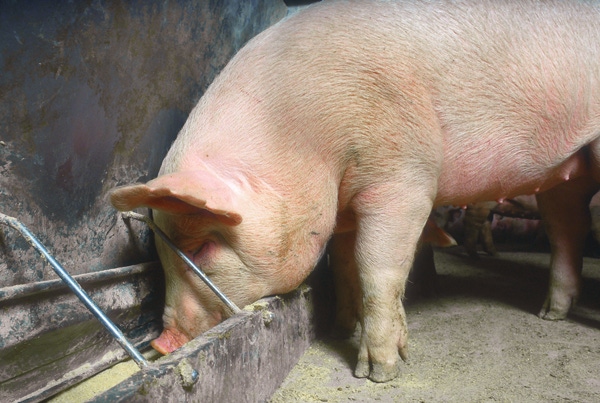Be Ready for Antibiotic Restrictions
If you are in the pork production profession, get ready for restrictions on the way you handle antibiotics, no matter what form they are delivered to your pigs, says James McKean, Iowa State University swine veterinarian and associate director of the Iowa Pork Industry Center.

If you are in the pork production profession, get ready for restrictions on the way you handle antibiotics, no matter what form they are delivered to your pigs, says James McKean, Iowa State University swine veterinarian and associate director of the Iowa Pork Industry Center.
The use of cephalosporins is one example of where restrictions have already occurred. Last April, the Food and Drug Administration (FDA) eliminated extra-label drug use for the popular antibiotic family, meaning that use of such popular swine antibiotics as Naxcel and Excede (Pfizer Animal Health), can only be used per label indications, said McKean in an address at the Iowa Pork Congress last month in Des Moines. The exception would be to treat a new disease allowable as an extra-label use.
FDA’s Guidance Document 209 is now official. Basically, the rule lays out public health concerns for the population in the form of allowable, judicious-use guidelines. It categorizes injudicious-use drug categories as well. The “voluntary” guidelines classify subtherapeutic use of antibiotics for growth promotion or improving nutritional efficiency as injudicious use, meaning that they will most likely be phased out over time, he explains.
Guidance 209 also suggests that medically important drugs used to assure public health should be restricted to use under veterinary oversight. “This is really talking about moving drugs from over the counter into prescription-like status and feed products into Veterinary Feed Directives (VFD). This is something that FDA says it wants to do over a period of three years,” McKean says.
That plan links drug use with specific disease agents. The problem it creates for drug manufacturers and producers is that there are syndromes not associated with a specific etiologic agent for which antibiotics would not be permitted under this guideline, he points out.
Guidance 213 is the instructional document to pharma about how to change the labels. According to McKean, it says if the voluntary label changes are proposed on injudicious uses, FDA will make the changes without additional requirements. If new claims are desired, companies must identify a specific pathogen to control, prevent or treat.
“The bottom line is that drugs used in animal production in the future are likely to move to prescription status or VFD, which in both cases require veterinary oversight,” McKean says.
Antibiotic Resistance
The Iowa swine veterinarian explains that antibiotic resistance is the “driving force behind all of this activity involving antibiotics, worldwide.” The movement began with the Swann Commission in the United Kingdom in 1969, suggesting that drugs should be restricted in food animals due to resistance.
In 1977, the FDA proposed a ban on subtherapeutic use of penicillin and tetracyclines. That proposal stalled and is now being reviewed by a New York court.
In Europe, various countries banned the use of antibiotics as growth promotants during the 1980s and 1990s, with a European Union-wide ban imposed in 2005, McKean says.
Antibiotic Residues
USDA’s Food Safety and Inspection Service (FSIS) has developed a more sensitive test for detection of antibiotic residues in kidneys of food-producing animals and has expanded the number of non-antibiotic compounds that will be tested. This has produced much lower detection levels and a noticeable increase in violative residues.
“There has been a substantial increase in the number of penicillin residue violations — and many of those have been in sows,” McKean says. “Today the packer can’t identify who sent them those animals, so the packer becomes the violator, unless responsibility can be shifted to the consolidator or producer.
“I will promise you that as inspectors get more positive samples in the slaughter plant, they will try to figure out where those positives came from by doing selective sampling,” he notes.
FSIS maintains a repeat-violator list on its Web site, which the bob veal and dairy industries are very familiar with, McKean continues. The last thing a packing plant or consolidator wants is to be on that list, so pork producers who have repeat antibiotic residue violations can expect pressure from packers and cull buyers.
FDA Inspections
Increased antibiotic residues probably will result in increased on-farm inspections by FDA officials. These inspections are very detailed and stressful, McKean says. FDA has the right to inspect your production facilities under the Food, Drug and Cosmetic Act because live animal facilities are considered food production establishments.
McKean’s advice: Be ready for an inspection. Be respectful and courteous to the inspector. Ask them why they are on your farm so you can narrow the scope of what they need to look at. Provide production records when requested. Answer their questions directly without elaboration or explanation/justification. Grant them a facility tour and make sure that what you are telling the inspector during an inspection is the same information that staff will tell him/her.
All pertinent drugs and drug records will be examined. Make sure your records include four things: the identification of the animals treated, the date drugs were administered, the amount of the drug given and the person who administered them.
“Remember that the inspector has a public health mandate, so don’t do anything to interfere with this process,” McKean says.
Let them review original documents, but only provide copies of production records.
Read the report they’ve written on your farm, but don’t sign it until all disagreements have been cleared up, he advises.
Resistance and Residues
Two different issues are of concern to pork producers: antibiotic resistance and antibiotic residues.
“The issue of antibiotic resistance will continue to cause people to question usage and eventually will cause some reductions in the antimicrobials that are available or the levels at which they can be used,” McKean states.
The second issue is antibiotic residues. FSIS has increased total testing, increased the sensitivity of the test they are using and increased the different compounds they are going to test for.
Pork producers can avoid encountering negative impacts from both issues by looking at the diseases in their operations and working out a herd health program with their veterinarian to reduce the health challenges and the antibiotics they use over the next couple of years, McKean stresses.
“Bacterial diseases like swine dysentery, brachyspira colitis and Actinobacillus pleuropneumonia, which require routine antimicrobial use for their control and treatment, are examples. Now would be a good time to work with your veterinarian to plan for disease removal,” he says.
See sidebar: "White Paper Addresses Antimicrobial Use, Resistance Issues."
About the Author(s)
You May Also Like





